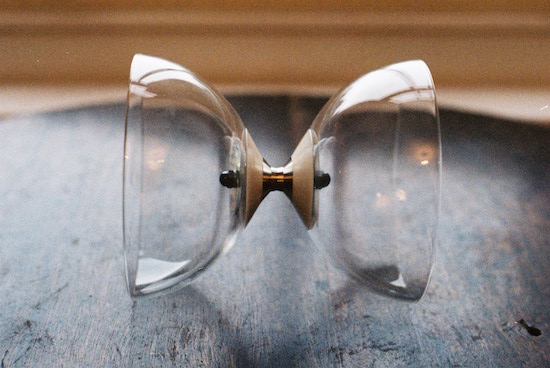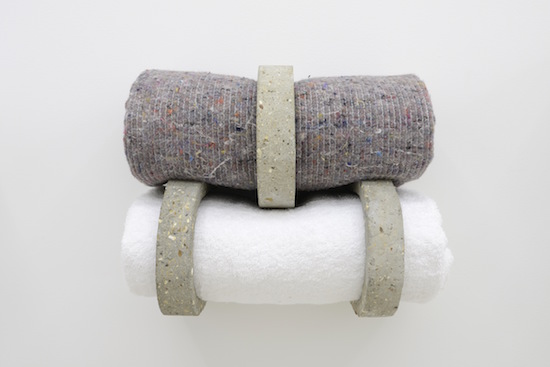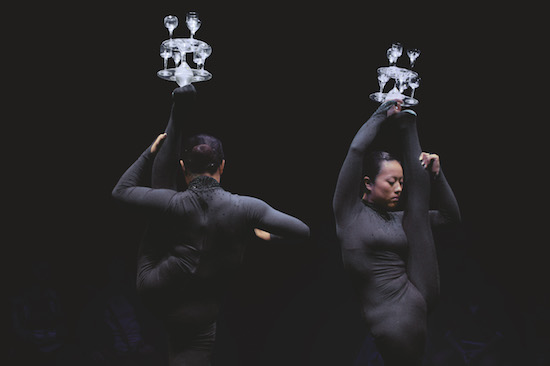Somehow the conversation had got derailed. Upstairs at the Camden Art Centre, in the anteroom between galleries, Rose English and Florian Roithmayr sat perched upon tall chairs around a table with Frieze magazine’s Paul Clinton. Despite the intimacy of the room, each wore radio mics which produced a gentle hoot of feedback between sentences.
We were in the midst of a Q&A for the opening night of English and Roithmayr’s new exhibitions at the Centre and, Clinton’s own questions exhausted, the mic was opened to the floor. But given that the talk preceded the actual opening of the galleries and, therefore, any chance to see the works in question, most in the crowd had little to ask. Until one woman, in the front row, elected to focus her comment instead on what might otherwise have been a throwaway line from earlier in the discussion.
“I’ve got one, if nobody else has –” she timidly broke the inevitable silence that follows any request for enquiry. “I’m intrigued,” she began, “about the distinction between an art object and a prop.”
Floodgates now flung open, the previously stagnant confab regained its flow. People began pitching in willy nilly. One spoke of Freud’s On Fetishism; another brought up Walter Benjamin’s Angelus Novus. “A prop has the character of a model,” chipped in a third, “they’re stand-ins, they refer to something. I think that’s why lots of artists are interested in props. It is to do with an illusion of an object.”
English herself can only equivocate in response. “Both categories of objects I find interesting,” she insists. “But it’s really fantastic to hear your description of what you perceive to be the difference between them.” Emphasis placed subtly but firmly on the “what you perceive”. Roithmayr, for his part, stays silent, withdrawing into his own inscrutable mien.
Examining, finally, the works themselves, it’s easy to see why. The objects variously placed and strewn, inhabiting both galleries of the Arts Centre, should scarcely be described as mere auxiliaries to any real or possible performance. Brimming already with all the tension and instability of action, it would be more accurate to say that these sculptures are themselves a kind of ongoing performance

In the 1970s, Rose English was part of a generation of artists who turned to performance in order to evade the commodification of the art object by defering to the immaterial and the ephemeral. Works like Quadrille(1975) reconfigured the carnivalesque zoomorphism of the village fête through the lens of a feminist deconstruction of the reification of women’s bodies. Performance, as she said before the Camden Arts Centre’s audience, was “a means of circumventing the problematics of the standalone art object.”
In the 1980s, she collaborated behind the camera with Sally Potter on the films, Thriller and The Gold Diggers, later even taking small parts in Nicholas Roeg’s film of The Witches and the TV crime series Cracker. At the same time, she developed a series of acclaimed solo shows, Plato’s Chair, The Beloved, and Adventure or Revenge. “I used to do monologues that would go on and on and on and on,” she laughs wistfully at the Centre, “but then I became more and more interested in things being spare and sparse.”
It was after something of an extravaganza for the Royal Court – Tantamount to Esperance, a piece involving aerialists, magicians, tango dancers, and more – that the series of analogies and equivalences that would ultimately inspire the present show began to come together for English. It was at this time that she discovered Walter Benjamin’s letter to Gershom Scholem about Klee’s Angelus Novum, “the angels,” wrote Benjamin, “– new ones each moment in innumerable bands – are created so that after they have sung their hymn before God, they cease and dissolve into the naught.” She was struck by this image of, as she puts it today, “the dense ephemerality of the word being sung.”
The work on display at Camden Arts Centre, then, takes several parts: a film of Chinese acrobats balancing towers of glass objects upon their upturned feet; a table of the very same glass objects (goblets, a juggler’s diabolo, and the like); a new composition for voices and percussion by Luke Stoneham to English’s own libretto; a video on three screens; and a series of works on paper that could be working notes, a kind of storyboard, or even something like a musical score. Linking each of these pieces is the perception of an analogy between song and glass, singer and glassblower, made through reference to their virtuosity – and especially their fragility.
There is an “inherent instability” to glass, English notes in response to one of Clinton’s questions. Always technically a liquid, never quite at rest, this most paradoxical of materials is prey to “interesting diseases” – like the crizzling depicted in the aforementioned paper works, which seems to make the very surface of the glass weep.

It is in this never-quite arrested motion of the material that English’s sculptures creep up to the territory inhabited by Roithmayr’s. His Fermata and Strike (both 2015) look at first like warrens eaten out by some crawling parasite or chemical abrasive. No such erosion has taken place. Both pieces are the result of a kind of struggle between competing materials: concrete and foam, placed tight within a sealed box and left to fight it out like gladiators – the one determined to expand, the other to constrain. Only on the day of the installation did Roithmayr himself even observe the results.
But he is hesitant, at Clinton’s suggestion, to refer to his process as a kind of “collaboration” with his materials. Roithmayr will admit to having “instigated”, “facilitated”, and “called into being” these objects, but not to having collaborated. “I let go,” he says simply. “I set the parameters and create this testing lab, but what’s happening in there unfolds without me.”
“Materials have innate properties,” he continues. “They do certain things. It doesn’t matter whether I am there or not. Maybe all I do is make it a little bit more explicit.” It is in this emphasis on objects that “do” certain things that the whole drama of Roithmayr’s show comes into play. Like English’s glass, nothing in this room is quite at rest. Every work heaves and writhes with enigmatic tensions, each one like a little opera that has frozen, drifting across the tundra in slow motion.
Rose English and Florian Roithmayr are at the Camden Arts Centre until 6 March


